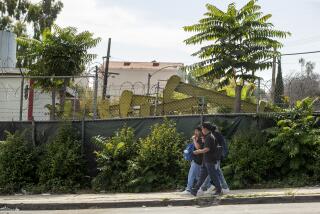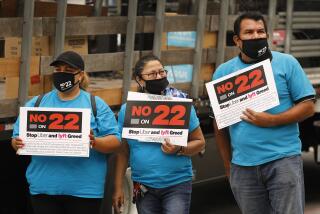High Court Rejects Ban on Gang Loitering
WASHINGTON — The Supreme Court struck down a Chicago anti-loitering law Thursday that authorized police to sweep the streets of those who look like gang members, disappointing Los Angeles area prosecutors who had hoped for a new weapon in their war against street gangs.
The 6-3 decision instead gave an unexpected endorsement to old-fashioned principles of civil liberties. Despite its laudable purpose, the Chicago law gave police too much power, the high court ruled, and it punished the normally innocent act of standing on a public sidewalk.
In a free society, police cannot be given unchecked authority to arrest citizens, even those who might be gang members, the justices said. Officers need some evidence of wrongdoing before they intervene.
Those who loiter for the purpose of selling drugs, soliciting prostitution or intimidating others, for example, can be ordered to “move on” or face arrest, the court said. These laws are linked to a criminal offense.
By contrast, Chicago’s 1992 ordinance told police to go after young men who were seen “loitering with no apparent purpose.” Once warned to disperse, these persons faced arrest if they failed to move on to the officer’s satisfaction.
To make arrests or win convictions under the law, the city did not need to show that the young men previously had been convicted of a crime, had committed a crime during their arrest or were planning to commit an offense.
As Justice John Paul Stevens, a Chicago native, noted, the law would have permitted the arrest of two young men standing outside Wrigley Field, even if they were simply waiting to see Cubs star Sammy Sosa leave the park.
By 1995, Chicago police had issued 89,000 dispersal orders under the ordinance and made 42,000 arrests. Most of those arrested were black or Latino. That year, a state court in Illinois halted the city’s enforcement of the law and sent the case moving to the Supreme Court.
For the justices, the case became a classic test of individual freedom versus public order.
A year ago, some prosecutors and conservative legal scholars said they believed that Chicago officials would prevail, thinking that a conservative-leaning Supreme Court was ready to give police a freer hand. The “gang menace” demanded a new, get-tough approach, city prosecutors said.
They argued that by controlling the sidewalks and public parks, the police could reduce crime and make the city livable for law-abiding residents of troubled neighborhoods. For those vulnerable citizens, they argued, it is not police power that is a threat but criminal street gangs.
In an angry dissent which he read in the court, Justice Antonin Scalia voiced that view. “I would trade my right to loiter any day in exchange for the liberation of my neighborhood,” he said. Since Chicago’s elected officials made that choice, the courts should uphold their effort “to eliminate this scourge,” he said.
But Scalia was joined only by his fellow conservatives, Chief Justice William H. Rehnquist and Justice Clarence Thomas.
The majority of justices seemed more concerned about tilting the scales too far in favor of the police and against the young men who encounter them every day.
Thursday’s ruling follows a year in which a series of police abuses have come to light, from the “racial profiling” of black and Latino motorists to unexplained police shootings in New York City and in Riverside, Calif. New York City also was torn by the trial of officers who brutally assaulted a handcuffed man in the bathroom of a police station.
“We can only speculate about the impact [on the justices], but these stories have been dramatic evidence that police abuses are still with us,” said University of Chicago law professor Stephen Schulhofer. For whatever reason, the justices “were in the end unwilling to loosen the long-standing constraints on the police,” he said.
Since Chicago’s law was new and untested, its demise should have no direct impact in California.
In recent years, local prosecutors in Southern California and San Jose have relied on a narrow, more targeted legal attack on gangs. They have gone before judges and obtained court injunctions that name particular gang members who operate in certain neighborhoods, often restricting their use of pagers and cellular phones as well as their presence on certain streets or in a rival gang’s territory.
“We have had quite a bit of success with the injunctions, but the Chicago approach would have made it easier,” said Dave Demerjian, a deputy Los Angeles County district attorney who heads the hard-core gang division. “We don’t enjoin gangs as such, only the members who are actively involved in gang activities.”
The state Supreme Court upheld this approach in a San Jose case in 1995 and Demerjian said that 18 injunctions have been issued targeting certain gang members in Los Angeles County and in the city of Los Angeles.
Indeed, Los Angeles has been the nation’s leader in the use of injunctions to control gang activity. The city has targeted members of the 18th Street gang and the Playboy Gangster Crips, among others. Police can arrest persons who violate the injunctions. Over the last several years, the city attorney’s office has prosecuted about 70 such cases.
This targeted approach in California avoids the problem of Chicago’s open-ended law, officials said. San Jose Mayor Ron Gonzales said that his city had never even considered the Chicago approach “because it seemed obviously constitutionally defective.”
As a practical matter, however, the injunctions are not nearly as effective. They are limited to a few specific blocks and to identified gang members. And they are enforced only after weeks of court hearings.
“If the gang moves to a different territory, you have to go back to court,” said Los Angeles County Deputy Dist. Atty. Brent Riggs.
The high court ruling was not a total loss, he noted, since Justice Sandra Day O’Connor encouraged city lawyers to consider other “reasonable alternatives to combat the very real threat posed by gang intimidation and violence.”
Riggs said that he and other county officials need time to study the ruling. “There might be something to extract from the opinion that could be used to draft an ordinance that is permissible,” he said.
For the high court, Thursday’s ruling was the third major victory for the liberal wing in three weeks. First, the justices struck down California’s plan to pay lower welfare benefits to newcomers on a 7-2 vote. Two weeks ago, the court expanded the law against sexual harassment, ruling that schools and colleges could be held liable if they failed to stop one student’s abuse of another. This came on a 5-4 ruling, with Justice O’Connor casting the key vote for the majority.
The outcome in the Chicago gang case did not come easy, however. The court took seven months to hand down the ruling, and six justices wrote opinions, four for the majority and two in dissent.
Scalia’s scathing dissent mocked the notion of “the Fundamental Freedom to Loiter” and scorned the majority opinion as “entirely irrational.” He spoke only for himself. Justice Thomas wrote a separate, more restrained dissent detailing the long history of anti-vagrancy laws, which the chief justice joined.
The lead opinion in the case (Chicago vs Morales, 97-1121), was written by Justice Stevens, who was appointed in 1975 by Republican President Ford. He is now probably the court’s most liberal member.
“The freedom to loiter for innocent purposes is part of the liberty” protected by the U.S. Constitution, he said. Chicagoans who stop to “engage in idle conversation or simply to enjoy a cool breeze on a warm evening” should not be subject to police commands, he said, if they have committed no other offense. Justices David H. Souter and Ruth Bader Ginsburg joined his opinion in full.
In separate statements, three other justices shunned the notion of a constitutional right to loiter and stressed that the Chicago law was unconstitutional because it did not focus on specific criminal conduct.
As written, it covers “a broad range of innocent conduct,” said Justice Anthony M. Kennedy. Justice Stephen G. Breyer attacked Scalia’s comment that the law was at most “a minor limitation” on the freedom of some people. “To grant a policeman virtually standardless discretion to close off major portions of the city to an innocent person is, in my view, to create a major, not a minor limitation,” he said.
Probably the most studied opinion will be O’Connor’s. She suggested that Chicago city lawyers redraft anti-gang laws to make it illegal to loiter to “establish control over identifiable areas or to intimidate others from entering those areas.” This would allow officers to move aside gang members who are preventing others from using parks or sidewalks, she said.
*
Times staff writer Carla Rivera in Los Angeles contributed to this story.
More to Read
Sign up for Essential California
The most important California stories and recommendations in your inbox every morning.
You may occasionally receive promotional content from the Los Angeles Times.











